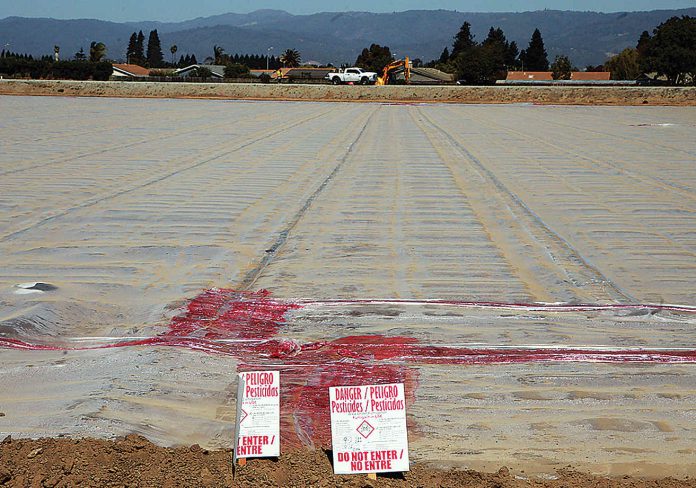
More than half of pregnant women in Monterey County are exposed to pesticides believed to be harmful to their fetuses, and a quarter of the pesticide used in California is applied in Monterey County.
Those statistics are part of a study released Sept. 30 by Public Health Institute’s Tracking California and UC Berkeley’s Center for Environmental Research and Children’s Health.
Several dozen community members gathered for a news conference by Safe Ag Safe Schools, Californians for Pesticide Reform, Future Leaders of Change and the California League of United Latin American Citizens at the County Government Center in Salinas on Sept. 30 to discuss the study.
The group called for immediate restrictions on organophosphate pesticide applications.
The peer-reviewed research analyzed pesticide application data and birth records across the state.
Researchers discovered that in 2021, more than half of all pregnant women in Monterey County lived within one kilometer of agricultural fields where organophosphate pesticides were applied during their pregnancies.
Living this distance from pesticide applications has been linked to serious health consequences for developing children, including lower IQ, neurodevelopmental problems and lung damage, the study states.
“Monterey County remains a hotspot for dangerous organophosphate pesticide use that threatens the brain development of children,” said Miriam Rotkin-Ellman, an independent public health researcher and lead author of the study. “To protect maternal and child health—and ensure environmental equity—communities need better protections from organophosphate pesticides. Buffer zones, restricting organophosphate use near homes, and phasing out these brain-harming pesticides will better protect future generations.”
Statewide, use of organophosphate pesticides dropped 54% between 2016 and 2021, largely due to the 2020 ban on chlorpyrifos. But Monterey County saw a 26% increase over that same period.
A quarter of all organophosphate pesticide use in California is in Monterey County—252,510 pounds out of 1,024,626 statewide (in 2021,) the report shows.
Bensulide—an organophosphate not approved in the European Union (EU)—was the most heavily used in the area, accounting for over 77,000 kilograms.
Other commonly applied organophosphate pesticides included acephate, malathion, naled, and dimethoate, all of which are banned in the EU.
The study also found that pesticide exposure in Monterey County disproportionately affects Latino families. Statewide, 7.5% of all pregnant women lived within a kilometer of organophosphate use. In Monterey County, that number jumped to 57% for Latino residents.
“These are frontline communities who live, work, and raise their families near fields where these toxic chemicals are applied,” said Yanely Martinez of Safe Ag Safe Schools (SASS). “We deserve the same level of protection as people in other parts of California rather than a policy of environmental racism.”Local community leaders in the Monterey Bay region are calling specifically for county agricultural commissioners to implement one-mile organophosphate-free buffer zones around residences, schools, hospitals and other sensitive sites, while demanding a complete statewide phaseout from the Department of Pesticide Regulation.










